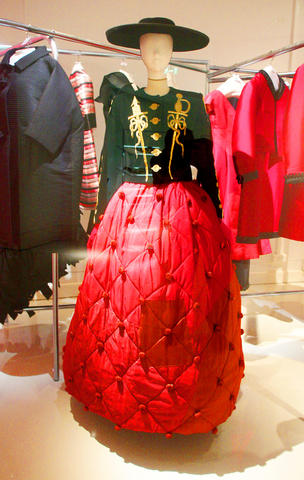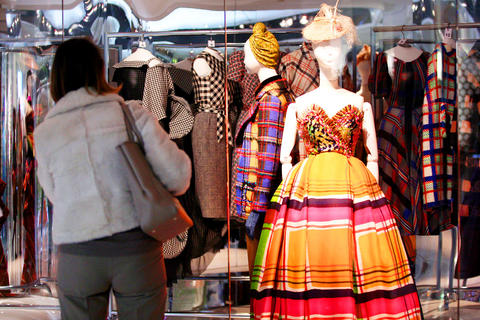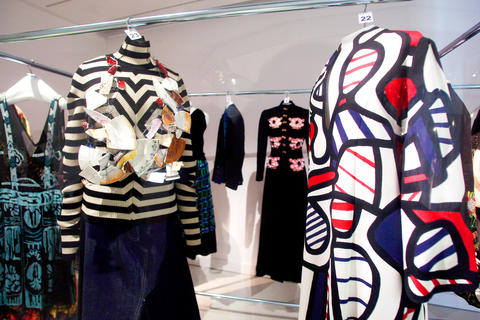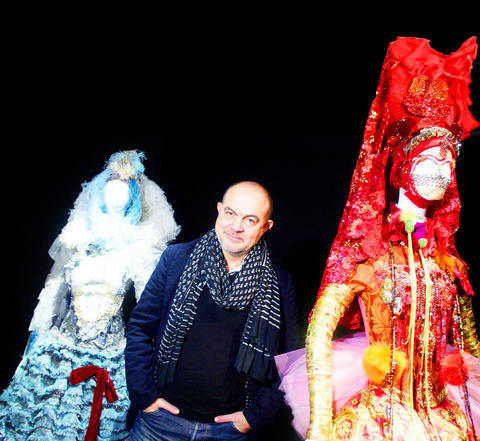Christian Lacroix, arguably the most extravagant couturier in Paris, never intended to be a fashion designer. His dream was to be a museum curator, a wish that finally came true via a breath-taking walk through two centuries of fashion.
For the past couple of years, Lacroix, 56 this year, spent most of his Friday mornings picking through 80,000 items of clothing old and new stocked at France's Decorative Arts Museum next door to the Louvre.
To mark the 20th anniversary of his own couture house this year, the museum had offered a show of his own lavish designs. But Lacroix declined.

PHOTO: AFP
"A self-promoting retrospective would have been a bit vulgar," he said.
"I wanted to show that my work is based on the wealth of museums such as this one."
Obsessed with costume since the age of six, and a dedicated history of art student who nonetheless failed France's tough museum curator exams, Lacroix narrowed down his choice of clothes to 1,400 then 500 "of the most inspiring items recounting the history of fashion."

PHOTO: AFP
At the show, titled Christian Lacroix, Histoires de Mode (History of Fashion) and running until April 20 next year, a final 400 dresses, capes, coats and hats dating back to the 18th century are displayed in counterpoint to 90 emblematic designs from Lacroix's own twice-yearly haute couture shows.
Alongside his iconic stripes from 1987 hang striped bustles and crinolines from the 1860s, while a black-and-white spotted 2001 number worn with a red crocodile-skin jacket stands by a red-spotted Schiaparelli evening coat from 1939 and a 1940 Lanvin gown in black and white spots.
There are groups of dresses in spots, stripes, checks, lames, flowery patterns, netting or patchwork. Gathered together by color, fabric, style or inspiration, the exhibition highlights how fashion constantly reinvents itself, said co-curator Olivier Saillard.

PHOTO: AFP
"Christian Lacroix is someone whose work is inspired by history and shows fashions coming around over and over again," said Saillard. "Fashion always repeats itself."
Celebrated for his exuberant swathes of lace and embroidery, and patchworks of fabrics in vibrant colors, Christian Lacroix hit the catwalks 20 years ago with dramatic designs inspired by the costumes of his native Arles in the south of France, and the Camargue, with its gypsies and bullfighters.
But while his roots remain an inspiration, he is known more than any other of the great French couturiers for harking back to the history of costume in his stunning fashion collections.

PHOTO: AFP
Along with dresses from the 18th and 19th centuries, the show features models by Lacroix contemporaries such as Yohji Yamamoto, Comme des Garcons or Yves Saint Laurent, alongside post-war classics from Christian Dior or Pierre Cardin as well as creations by early couture czars Worth, Poiret and Jeanne Lanvin.
"There are not only the big names but also anonymously-made clothing," Lacroix said. "The show is a hymn to Parisian couture."

On April 26, The Lancet published a letter from two doctors at Taichung-based China Medical University Hospital (CMUH) warning that “Taiwan’s Health Care System is on the Brink of Collapse.” The authors said that “Years of policy inaction and mismanagement of resources have led to the National Health Insurance system operating under unsustainable conditions.” The pushback was immediate. Errors in the paper were quickly identified and publicized, to discredit the authors (the hospital apologized). CNA reported that CMUH said the letter described Taiwan in 2021 as having 62 nurses per 10,000 people, when the correct number was 78 nurses per 10,000

As we live longer, our risk of cognitive impairment is increasing. How can we delay the onset of symptoms? Do we have to give up every indulgence or can small changes make a difference? We asked neurologists for tips on how to keep our brains healthy for life. TAKE CARE OF YOUR HEALTH “All of the sensible things that apply to bodily health apply to brain health,” says Suzanne O’Sullivan, a consultant in neurology at the National Hospital for Neurology and Neurosurgery in London, and the author of The Age of Diagnosis. “When you’re 20, you can get away with absolute

May 5 to May 11 What started out as friction between Taiwanese students at Taichung First High School and a Japanese head cook escalated dramatically over the first two weeks of May 1927. It began on April 30 when the cook’s wife knew that lotus starch used in that night’s dinner had rat feces in it, but failed to inform staff until the meal was already prepared. The students believed that her silence was intentional, and filed a complaint. The school’s Japanese administrators sided with the cook’s family, dismissing the students as troublemakers and clamping down on their freedoms — with

As Donald Trump’s executive order in March led to the shuttering of Voice of America (VOA) — the global broadcaster whose roots date back to the fight against Nazi propaganda — he quickly attracted support from figures not used to aligning themselves with any US administration. Trump had ordered the US Agency for Global Media, the federal agency that funds VOA and other groups promoting independent journalism overseas, to be “eliminated to the maximum extent consistent with applicable law.” The decision suddenly halted programming in 49 languages to more than 425 million people. In Moscow, Margarita Simonyan, the hardline editor-in-chief of the